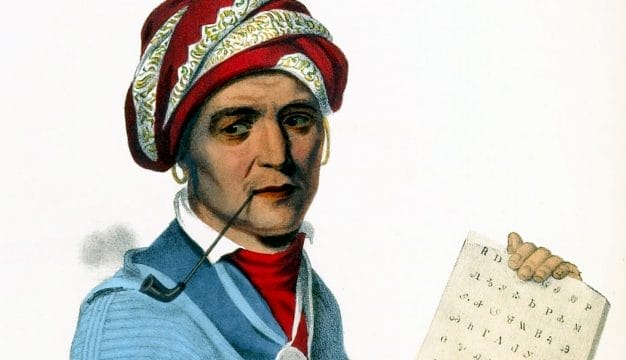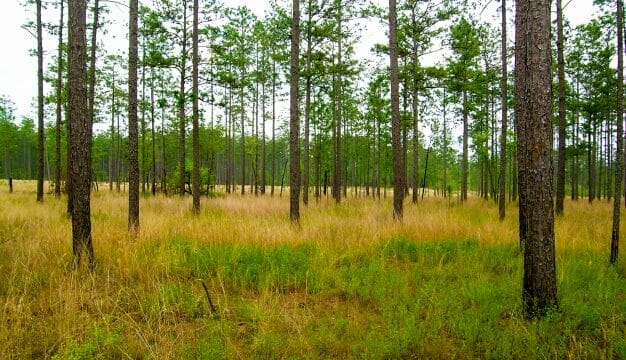Moundville Native American Festival
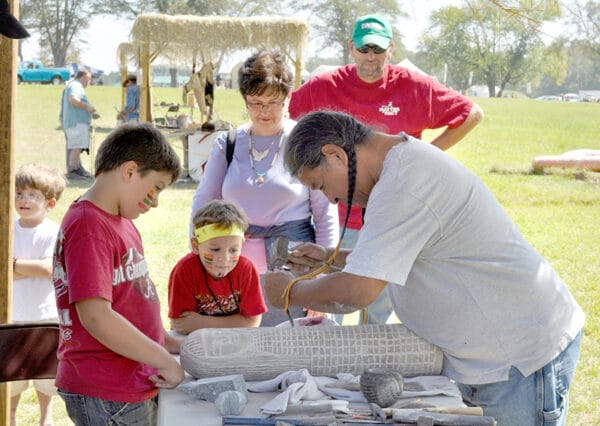 Soapstone Carving
The Moundville Native American Festival celebrates the arts, crafts, and lifeways of the Native Americans of the Southeast. It is held in early October at Moundville Archaeological Park, which straddles Hale and Tuscaloosa Counties. Festival sponsors aim to increase understanding and appreciation of the cultures and heritage of southeastern Native Americans through presentations, activities, and interpretive programming. In addition, they hope to dispel stereotypes about Indian life and history that have developed as a result of cinematic and other over-stylized portrayals that arose during the second half of the twentieth century.
Soapstone Carving
The Moundville Native American Festival celebrates the arts, crafts, and lifeways of the Native Americans of the Southeast. It is held in early October at Moundville Archaeological Park, which straddles Hale and Tuscaloosa Counties. Festival sponsors aim to increase understanding and appreciation of the cultures and heritage of southeastern Native Americans through presentations, activities, and interpretive programming. In addition, they hope to dispel stereotypes about Indian life and history that have developed as a result of cinematic and other over-stylized portrayals that arose during the second half of the twentieth century.
The festival began in 1989 as part of the fiftieth anniversary celebration of the opening of the park’s Jones Archaeological Museum, which is a unit of the University of Alabama Museums system. It began as a single circle of arts and crafts vendors who demonstrated their work at their sales booths. State and federally recognized tribes supporting the initial festival included the Poarch Band of Creek Indians, the Mississippi Band of Choctaw Indians, the Chickasaw Nation, and the Echota Cherokees. Many other individuals attending the first few festivals were not affiliated with specific tribes but claimed southeastern Indian ancestry. The first festival had only a modest budget of a few thousand dollars provided by the museum system, but in recent years university funds have been supplemented by sponsors who have donated money, supplies, and services. The festival is governed through Moundville Archaeological Park.
The Moundville Native American Festival hosts an average of 12,000 visitors annually, mostly schoolchildren from west-central Alabama and east-central Mississippi. More than 200 Native American and non-Indian experts share their knowledge about southeastern Indian culture through demonstrations, presentations, and performances. Festival presenters, artists, and craftspeople are carefully selected for the quality of their work and their ability to communicate their knowledge. Visitors are encouraged to engage in hands-on activities, “living history” reenactments, musical and storytelling performances, archaeological and natural history interpretations, and a wide variety of arts, crafts, and technology demonstrations.
 Native American Foods
The festival consists of four major educational areas: the Arts and Craft Arbors, the Living History Camp, the Children’s Area, and the Native American Stage. Other components include the Trader’s Circle and Arts Market, Knapper’s Corner, and the Food Court. Each area presents aspects of Indian culture from a different perspective.
Native American Foods
The festival consists of four major educational areas: the Arts and Craft Arbors, the Living History Camp, the Children’s Area, and the Native American Stage. Other components include the Trader’s Circle and Arts Market, Knapper’s Corner, and the Food Court. Each area presents aspects of Indian culture from a different perspective.
The Arts and Craft Arbors area is comprised of eight brush arbors arranged in a rectangle to resemble a traditional Creek tribal town, which typically features such arbors erected for ceremonies and assigned to different clans. Within each arbor, demonstrators make and explain arts, crafts, and technologies, such as beadwork, basketry, pottery, stone carving, finger weaving, metal working, and bow and arrow manufacturing and use.
Resembling a hunting encampment of the late seventeenth and early eighteenth centuries, the festival’s Living History Camp features re-enactors preparing foods typical of the period, including wild game, corn, beans, and squash, and a variety of wild plants. Trade goods, such as stacks of deer hides, beads, goods made of metal, and foodstuffs are displayed in period-style tents along with dishes, pots, pans, clothing, weapons, and many other items authentic to that era. Interpreters dressed in period clothing discuss aspects of the deer trade in the Southeast. Other living history characters, such as a Mississippian Indian and a historic Creek fisherman, appear throughout the park.
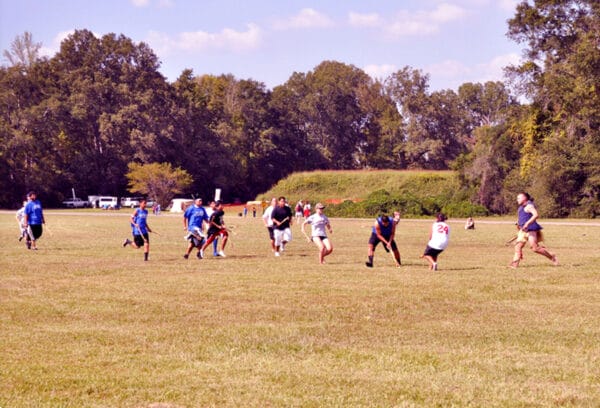 Stickball Match
Activities in the Children’s Area include trying on traditional clothing from various tribes, making a shell-bead necklace, and face painting with southeastern Indian designs. Youths may also play games such as stickball, Indian football, and “Tribal Twister.” Similar to the traditional game of Twister, this version is played on a large painted map of North America that shows the locations of traditional homelands of various Native American tribes in place of colored circles.
Stickball Match
Activities in the Children’s Area include trying on traditional clothing from various tribes, making a shell-bead necklace, and face painting with southeastern Indian designs. Youths may also play games such as stickball, Indian football, and “Tribal Twister.” Similar to the traditional game of Twister, this version is played on a large painted map of North America that shows the locations of traditional homelands of various Native American tribes in place of colored circles.
The Native American Stage features singing, dancing, storytelling, and instrumental music. Some of these performances are handed down as part of a particular tribe’s traditions; other music is contemporary with a flavor distinct to the traditional music of the Southeast. Many musicians who have performed at the festival have received Native American Music Awards (NAMMYs), such as Grammy-winning flutist Mary Youngblood.
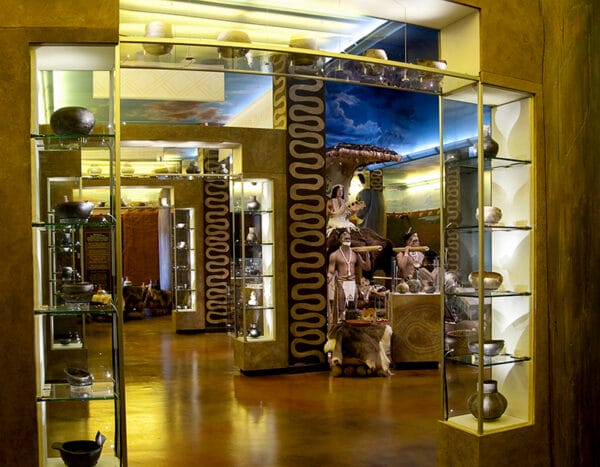 Jones Archaeological Museum
Moundville Archaeological Park is located on the banks of the Warrior River about 14 miles south of Tuscaloosa, just outside the town of Moundville. The park covers 300 acres that preserve more than 20 pyramidal earthen mounds dating from the Mississippian Period (AD 1000-1550). The accompanying Jones Archaeological Museum displays some 200 artifacts from the site’s excavations and is considered to be one of the finest museums of its kind. Realistic, life-sized figures within the museum portray the Moundville people and their interactions with other native people. In 2010, an extensive renovation of the facility was completed. During the festival, guides are stationed at key locations to interpret the archaeology and natural history of both the site and the museum.
Jones Archaeological Museum
Moundville Archaeological Park is located on the banks of the Warrior River about 14 miles south of Tuscaloosa, just outside the town of Moundville. The park covers 300 acres that preserve more than 20 pyramidal earthen mounds dating from the Mississippian Period (AD 1000-1550). The accompanying Jones Archaeological Museum displays some 200 artifacts from the site’s excavations and is considered to be one of the finest museums of its kind. Realistic, life-sized figures within the museum portray the Moundville people and their interactions with other native people. In 2010, an extensive renovation of the facility was completed. During the festival, guides are stationed at key locations to interpret the archaeology and natural history of both the site and the museum.
Many Native Americans attending the festival, especially those from tribes such as the Cherokee and Creek Indians who were forcibly removed from the Southeast in the mid-nineteenth century, consider the park to be a sacred site and the festival to be a homecoming. The festival has grown into one of the largest and best known Native American festivals in the Southeast. It was designated a Cultural Olympiad Event by the 1996 Olympic Games and has received awards from the Alabama Tourism Department, the Tuscaloosa Convention and Visitors Bureau, and the West Alabama Tourism Awards, all of which recognized the festival as an outstanding event. The National Bus Association named the Moundville Native American Festival as one of North America’s top 100 bus-tour events. It has been consistently listed as one of Alabama’s top 20 tourism events by the Alabama Tourism Department.

